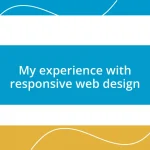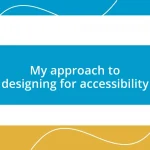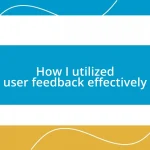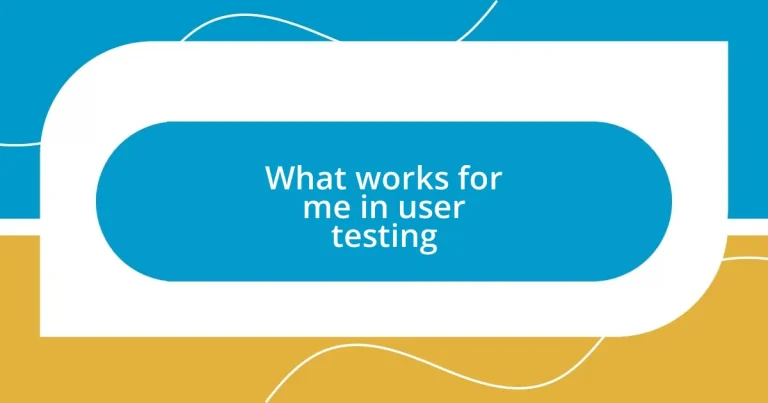Key takeaways:
- User testing emphasizes the importance of empathy, where understanding user emotions can significantly enhance design effectiveness.
- Identifying diverse target user groups is crucial for collecting relevant feedback that drives meaningful product improvements.
- Combining qualitative feedback methods, like interviews and think-aloud protocols, with quantitative metrics helps in achieving a balanced understanding of user experiences.
- Iterating based on user insights is essential, as direct user feedback often uncovers critical issues that data alone may not reveal.
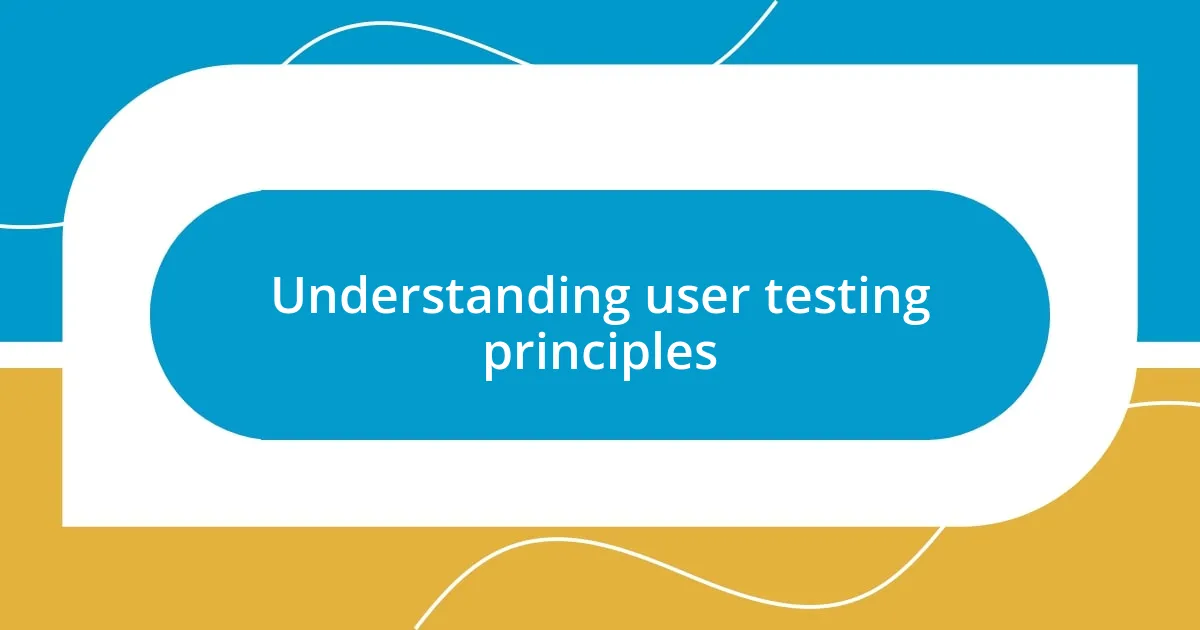
Understanding user testing principles
User testing is all about observing real users interacting with a product, and it’s fascinating how their feedback can unveil insights you might never consider on your own. I remember watching a user struggle to find a simple button, thinking, “How could we have missed that?” That moment taught me that usability often hinges on clarity over complexity.
It’s essential to embrace the principle of empathy in user testing. I’ll never forget an instance where a participant shared their frustration with our design, expressing how it made them feel less competent. It really hit me—design isn’t just functionality; it’s about making users feel capable and understood. Have you ever had a similar realization that shifted your perspective on your work?
Moreover, the iterative nature of user testing is crucial. Each round of testing offers opportunities for learning and improvement, as I’ve experienced firsthand. I’ve found that even small tweaks based on user feedback can lead to substantial enhancements in overall satisfaction. Why not consider how your current methods could evolve through continual user insights?
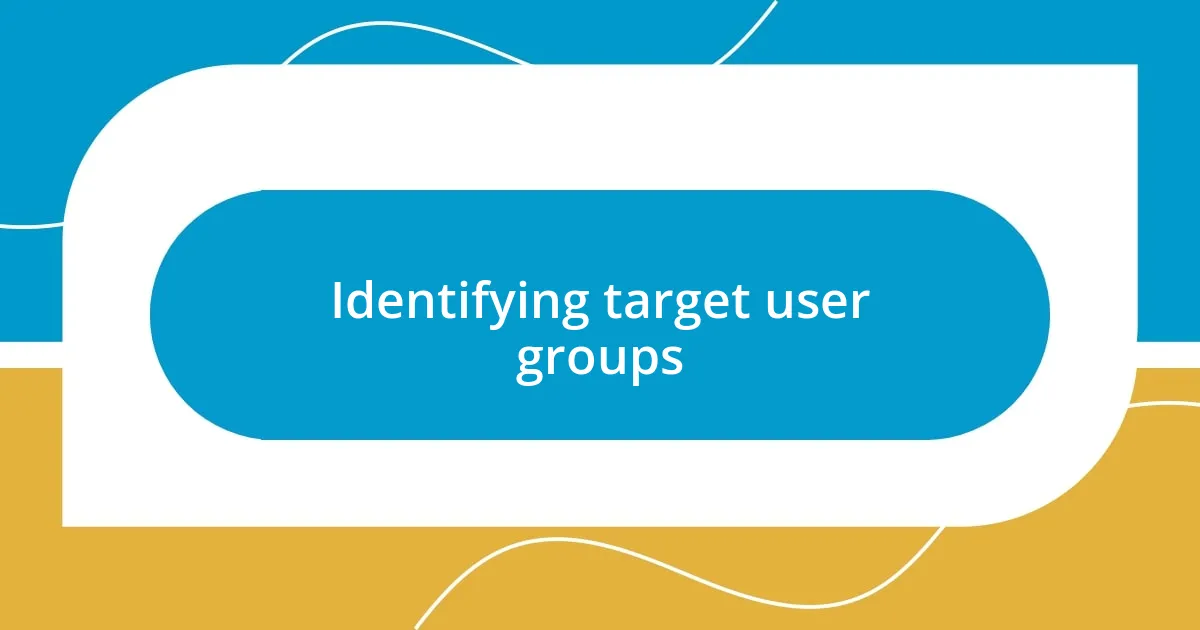
Identifying target user groups
Identifying the right target user groups is a pivotal step before diving into user testing. From my experience, defining these groups not only streamlines the testing process but also ensures that the feedback we get is relevant and actionable. I recall a project where we nearly overlooked a significant demographic—a group that ended up providing the most enlightening insights about our product’s usability. Their unique perspectives reminded me that everyone has a different relationship with technology, and understanding these nuances can lead to meaningful improvements.
To effectively identify target user groups, consider the following:
- Define demographics: Age, gender, location, and profession can influence user behavior.
- Analyze psychographics: Interests, values, and lifestyle choices help shape user expectations.
- Use existing data: Leverage analytics from current users to spot trends and patterns.
- Create personas: Develop fictional characters that represent specific segments of your audience.
- Involve real users: Conduct surveys or interviews to gain firsthand insights on who your users really are.
Finding the right mix of users can transform your testing experience, as I’ve seen it firsthand. The blend of knowledge gained by encompassing diverse user groups can significantly elevate the quality of your product.
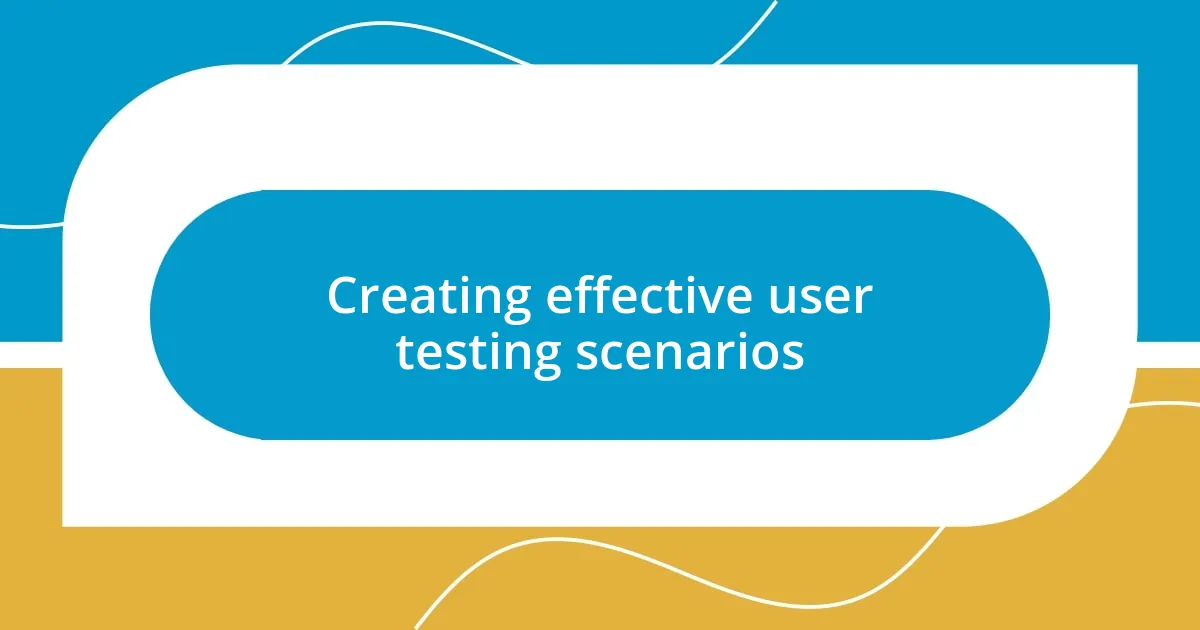
Creating effective user testing scenarios
Creating user testing scenarios that resonate with your target audience is both an art and a science. I’ve learned that establishing context is paramount. For instance, I once crafted a scenario that mimicked a real-life situation where a user needed to quickly purchase a train ticket on their mobile device. Watching them navigate through the process revealed not just usability issues, but also the emotional stress that accompanied their experience. By rooting testing scenarios in real-world contexts, we create a more authentic atmosphere for feedback.
Additionally, focusing on specific tasks within these scenarios can yield valuable insights. I remember designing a test where participants were asked to complete a task involving multiple steps—like setting up a user profile. The different approaches they took were eye-opening. Some breezed through while others floundered due to unclear guidance. This contrast highlighted how critical it is to break down tasks and articulate expectations clearly for users. Creating scenarios that strike the right balance between challenge and guidance can be truly revealing.
Now, let’s look at how we can differentiate various aspects of user testing scenarios in a more structured way:
| Aspect | Effective Scenario Features |
|---|---|
| Context | Real-life situations that users can relate to enhance realism. |
| Specific Tasks | Crisp, focused tasks that reveal user behavior under pressure. |
| Feedback Mechanism | Structured follow-up questions to capture user emotions and thought processes. |
| Flexibility | Allowing users to take different paths can provide richer insights. |
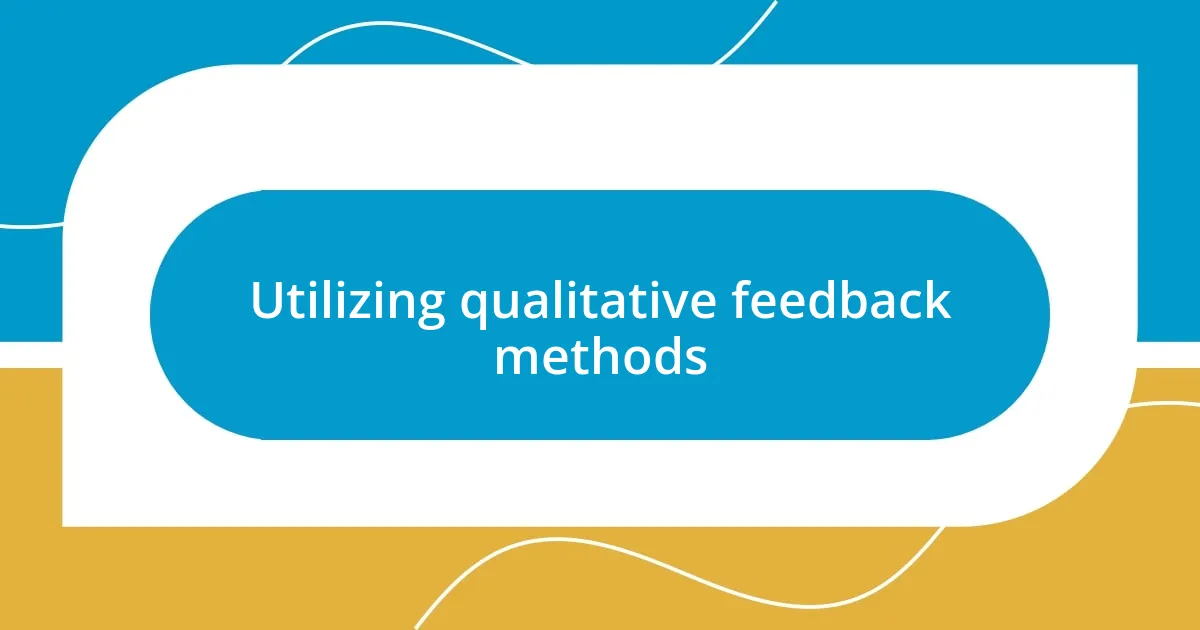
Utilizing qualitative feedback methods
Utilizing qualitative feedback methods can open up a treasure trove of insights beyond what numbers can tell us. I vividly remember a round of user testing where I invited a small group for in-depth interviews after observing them interact with our product. Listening to their stories—the frustration, the moments of delight—provided context that raw data simply couldn’t capture. These conversations revealed patterns in user behavior that led to changes in our interface, enhancing the overall user experience.
One effective approach I’ve embraced is using open-ended survey questions. While metrics give us a bird’s eye view, qualitative responses provide a ground-level perspective. I’ve found that asking users “What do you wish was different about the experience?” often unveils gems of feedback. One user shared a down-to-earth observation about a feature they found confusing, which, to my surprise, a significant number echoed. It highlighted how sometimes, the simplest changes can have the biggest impact on usability.
Finally, I love to incorporate think-aloud protocols during testing sessions. Asking participants to verbalize their thoughts as they explore our product can feel a bit intrusive at first, but the insights are invaluable. For instance, during a session focusing on a navigation menu, one participant’s candid frustration with the way items were labeled turned into an enlightening discussion among my team. It made me wonder, how many other users might silently struggle without voicing their concerns? Such moments remind me of the profound value of qualitative feedback in creating a user-centric product.
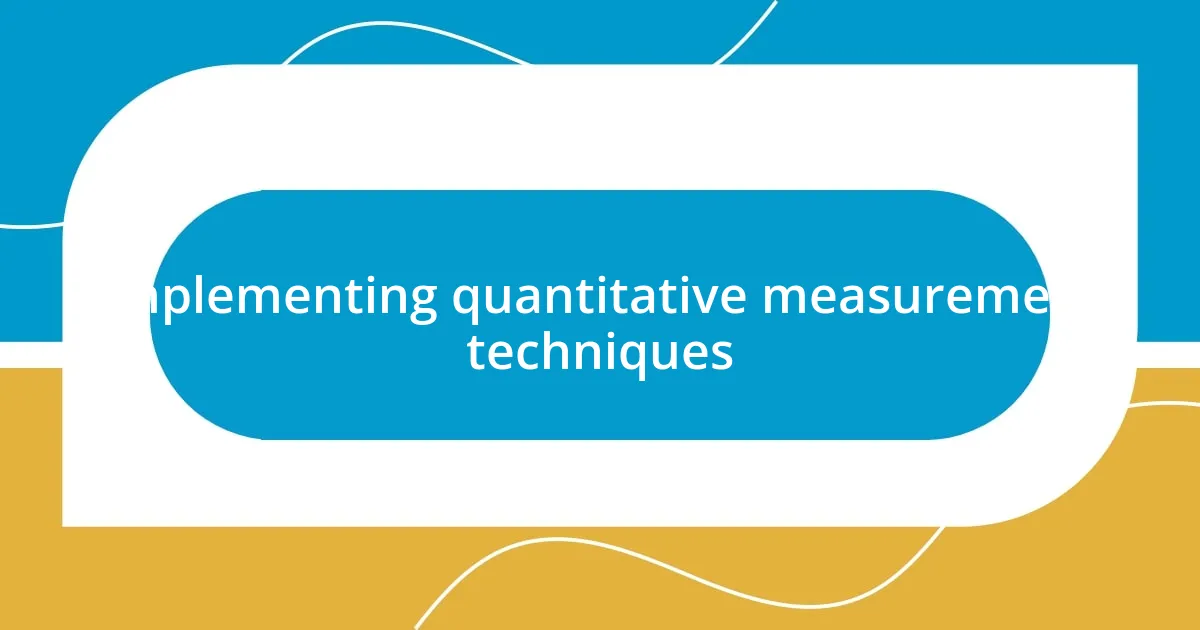
Implementing quantitative measurement techniques
When it comes to implementing quantitative measurement techniques in user testing, I’m a firm believer in the power of metrics to guide our design decisions. One time, I conducted usability tests that incorporated heatmaps to visualize where users clicked most frequently. It was fascinating to see how certain elements attracted attention while others were blatantly ignored. This data provided concrete evidence to support adjustments in our layout, transforming our approach to user engagement.
Using structured metrics like task completion rates can also be a game-changer. I recall a testing session where we quantified how quickly users completed specific tasks, and the results were eye-opening. One task took significantly longer than we anticipated, prompting a deeper dive into the design. This metric helped highlight a critical usability issue that would have otherwise gone unnoticed. In those moments, I find myself asking, “What can we do better?” Metrics answer that, pushing for improvements that resonate with users.
Lastly, I’ve found that A/B testing can deliver insights that are both compelling and actionable. During a recent project, we compared two versions of a landing page, measuring bounce rates and conversions. The results were stark—one version outperformed the other significantly. This kind of direct comparison fueled our decision-making process with real data, underscoring how important it is to back up our gut feelings with hard numbers. Isn’t it reassuring to see data confirm your instincts? That marriage of intuition and analytics can really refine our approach to user experience.
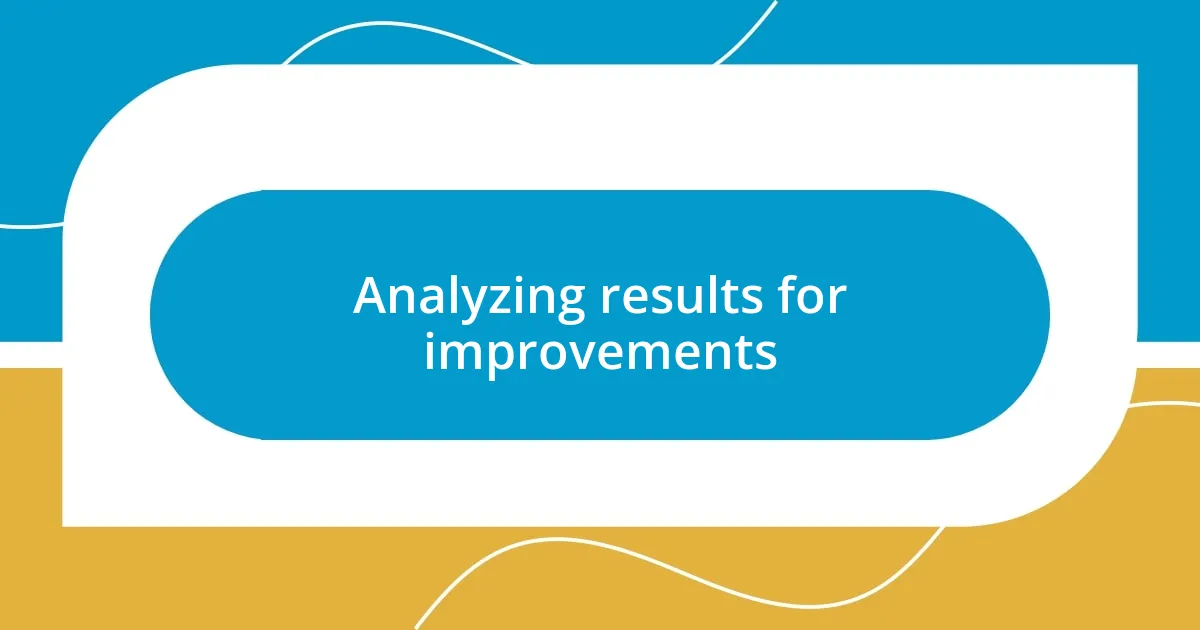
Analyzing results for improvements
Analyzing results for improvements is where the real magic happens. I remember dissecting user testing data late into a Friday night, my coffee growing cold as insights began to emerge. One particular finding about the drop-off rate at a specific stage of our onboarding process felt like a lightbulb moment. It was clear that users were struggling, and that pushed us to dive deeper—what were the exact pain points they encountered?
I always make it a point to trace back through the user journey when analyzing results. By mapping out each step, I can identify where friction occurs and why. During a recent analysis, I noticed that users consistently hesitated at a certain question in our form. That led me to rephrase it based on feedback until it became clearer. This iterative process taught me that sometimes, even a minor tweak can lead to significant improvement in user satisfaction. Have you ever experienced that sudden clarity when the perfect solution clicks into place?
Another technique I love is cross-referencing qualitative and quantitative data. After conducting tests, I once discovered an alarming disconnect: while users expressed satisfaction in interviews, the metrics showed they weren’t converting. That contrast revealed a deeper issue—users liked the idea, but our implementation fell flat. This experience reinforced my belief that successful analysis must look for harmony in the data: numbers and narratives must sing the same tune to truly guide us toward meaningful improvements.
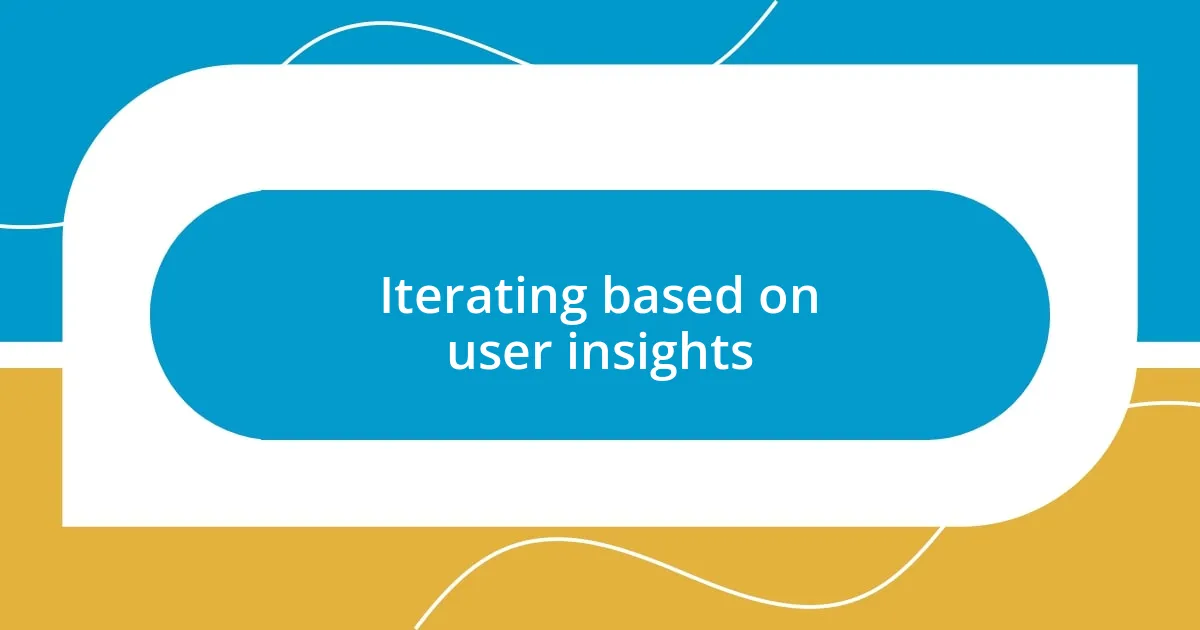
Iterating based on user insights
When I think about iterating based on user insights, I often recall a particularly eye-opening project where user feedback directly reshaped our approach. After our initial round of testing, a user commented that a certain feature was “confusing and unnecessary.” I felt a pang of realization—what was intuitive to me wasn’t clear to everyone else. It was in that moment I understood the importance of listening deeply to our users; their insights are not just feedback but a compass guiding our design iterations.
In another instance, I found myself at a crossroads with a product’s functionality. Data showed that users were abandoning the flow at a specific point, but the reasoning was murky. I decided to set up a follow-up session with several participants to delve into their thoughts. Their candidness was incredibly refreshing; they pointed out nuances I hadn’t even considered. It’s fascinating how a simple conversation can illuminate paths forward that raw data alone might miss. Have you ever noticed how the most impactful insights often come from hearing the user’s voice?
Every time I iterate based on user feedback, I feel an exhilarating blend of anticipation and nervousness. There’s always that question in the back of my mind: “Will this change resonate with users?” I remember a moment when we revamped a particular feature entirely based on testing results. After launching the new version, I eagerly monitored the user engagement metrics. When I saw a significant uptick, I couldn’t help but smile. There’s an undeniable thrill in witnessing how user insights can lead to meaningful, successful iterations. It’s like having a front-row seat to the evolution of design—exciting and profoundly validating.









